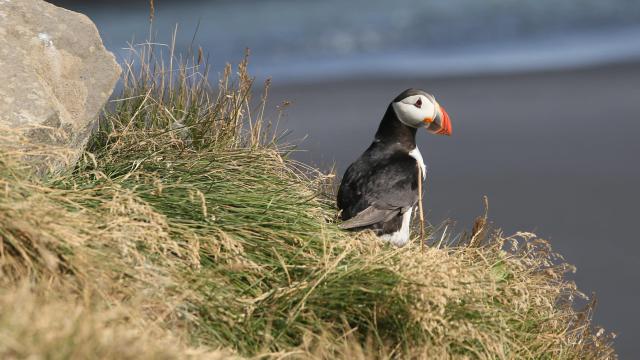Researchers watched puffins use sticks to scratch their backs and chests—a behaviour previously unknown to scientists.
There’s already mounting evidence that certain birds possess advanced intelligence. New Caledonian crows fashion advanced tools, cockatoos dance to music, and chickadees can remember where they hid of thousands of cached food items. But there are still a lot of open questions about how tool use arises, in what groups, and why. This research adds another species to the list of known tool users—one that surprised the researchers. Seabirds, they write, aren’t often seen using tools.
“As such, seabirds’ cognitive capacities may have been considerably underestimated,” the authors write in the paper published this week in the Proceedings of the U.S. National Academy of Sciences. “The fact that to date the only other birds seen scratching with a stick are parrots, prolific tool users and problem solvers, supports this hypothesis.”
The researchers used motion-activated cameras to film Atlantic puffins in two North Atlantic colonies, one on Skomer Island in Wales and another on Grimsey Island in Iceland. In one case, the camera caught a puffin using its bill to scratch its back with a stick for five seconds. In another, the puffin used the bill to scratch its chest feathers. The researchers ruled out that the sticks were simply haphazardly carried nest material, as puffins line their nests with soft things like feathers and grass, not sticks, and in the case of the back scratcher, the puffin was sitting on the sea, far from its nest.
Tool use isn’t common, but it occurs across different animal groups, mainly to assist with feeding. Other non-human animals will use tools to assist in body care; scientists have observed parrots, elephants, and primates scratching with sticks, while many birds will rub ants on their feathers—the birds may use the formic acid that the ants produce to keep insects or other parasites off of their wings. In the case of the puffins, researchers hypothesize that they might be using the sticks to dislodge ticks, but this would be up to future research to confirm.
Birds that spend most of their time at sea aren’t known for tool use, since their superior swimming abilities are usually sufficient to help them get food. At the same time, it’s possible that these behaviours aren’t known simply because seabirds are hard to observe, since they spend most of their time at sea and breed on inaccessible islands.
The fact that two distant puffin colonies both contain individuals using tools could suggest that either this behaviour is either genetic or it arose separately in two innovative individuals, which is evidence that puffins could be smarter than previously thought. And finally, puffins are part of the same suborder as gulls, which have been documented using bait to fish.
In the paper, the researchers encourage their peers to investigate tool use in species that might not be considered good tool-use candidates. The study’s first author, Annette L. Fayet from the University of Oxford, told Gizmodo in an email: “Many more species may also be using tools, but we simply haven’t observed them yet.”
